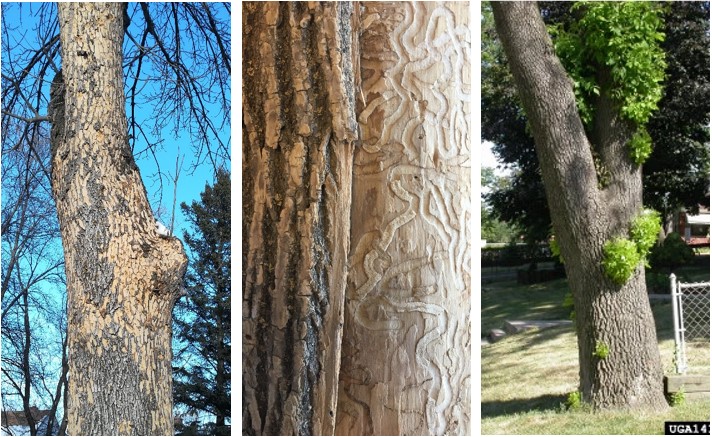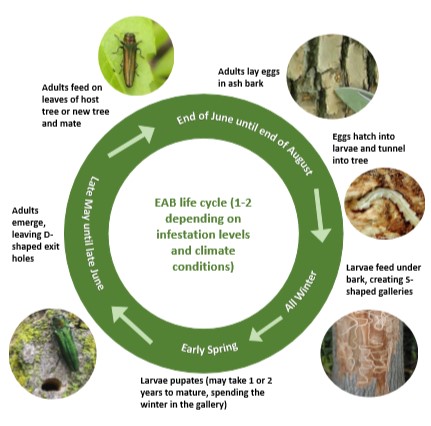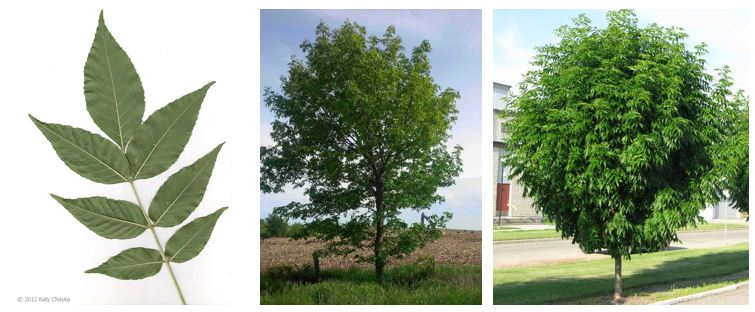About Emerald Ash Borer
Emerald Ash Borer (EAB) is an invasive wood-boring insect from China and eastern Asia that was introduced to North America in 2002. EAB attacks and kills healthy and stressed ash trees, and all ash species are susceptible to it to varying degrees.
Emerald Ash Borer in Winnipeg, Manitoba
On November 30, 2017, EAB was officially confirmed in Winnipeg. It is still uncertain the extent EAB will have in Winnipeg. In other cities, up to 99% of ash trees have been lost. It is estimated that there are approximately 356,000 ash trees, making up about 40% of Winnipeg’s urban forest.
Other cities that have experienced EAB have lost up to 99 % of untreated ash trees within 2 to 10 years. However, once an ash tree dies from EAB, it dries out quickly and can become unstable and hazardous. Many of Winnipeg’s ash trees are large, mature shade trees, meaning once they start to decay, there may be risk to people, property, and vehicles.
What to Look for:
It usually takes time for trees infested with EAB to show signs of decline, but once they do, symptoms generally include:
- Dying branches near the top of the tree;
- Suckers (epicormic shoots) emerging from the trunk or the base of the tree;
- Unusually heavy seed-crops;
- Trunk deformities, such as cracks and splits;
- Woodpecker damage, called blonding.
If you notice any of these signs, contact us or 311 right away.

How to Prepare For EAB
We advise private property owners with ash trees to consider the following 4 main steps:
- INVEST: Water ALL your trees well, practise tree species diversity, don’t move firewood
- Water ALL your trees well.
- When planting, consider a mix of different species and ones that do well in Manitoba. Species diversity will increase the urban canopy resiliency to invasive pests. Each spring, we offer our popular ReLeaf Tree Planting Program to promote species diversification and educate homeowners on proper planting techniques.
- Don’t move firewood. Burn it where you buy it. EAB and many other invasive insects are largely spread through the movement of firewood and other wood products. On its own, EAB doesn’t move very far. Hiding in wood products, though, it can travel vast distances – from city to city, province to province, state to state, and country to country.
- The City of Winnipeg has been regulated by the Canadian Food Inspection Agency (CFIA) for EAB. Any movement of all firewood of all species, ash nursery stock or ash wood (including wood chips, wood packaging, or dunnage) out of Winnipeg is prohibited without written permission from the CFIA.
- ASSESS: Hire a qualified, licensed, and insured professional arborist to examine your trees
- Have a qualified and insured professional arborist examine your ash trees. An ISA Certified Arborist can properly assess, advise, and provide care for all trees, including ash trees. For more information on arborists click here.
- PLAN: Explore your options and decide on a plan that’s right for you
- Preventative Chemical Treatments by an ISA Certified Arborist: Injectable insecticides are available for those who want to try to protect high-value ash trees on their property. These treatments are most effective when applied to healthy trees and must be repeated every couple of years. A professional arborist should administer these treatments. For tips on how to find an arborist, click here.
- The Slow Ash Mortality Approach – SLAM: Unlike Dutch elm disease, EAB, unfortunately, can’t be managed. However, it is possible to delay the effects. One way is adopting the City of Winnipeg’s SLAM approach. SLAM, or "Slow Ash Mortality," involves selecting some ash trees for treatment, which buys time for property owners to plan, remove, and replace trees.
- Tree Removal: Regardless if you choose to take preventative measures for your ash trees, or not, there is value in planning and budgeting for tree removal. Once an ash tree dies from EAB, it dries out quickly and can become unstable and hazardous. Many of Winnipeg’s ash trees are large, mature shade trees, meaning once they start to decay, there may be a risk to people, property, and vehicles.
- An arborist can help you choose a plan, budget, and timeline that’s best for you.
- Some municipalities in Canada and the United States are removing healthy ash trees on public property as a preventative measure
- Report Suspicious Trees and Symptoms on Public Property: If you see an ash tree displaying any of the symptoms of EAB, please report it. Vigilance may help the impact of EAB on public property. Contact us or contact 311 right away.
- Caring for City-Owned Trees: If you wish to have boulevard or other city-owned ash trees treated or pruned at your own expense, you can apply for permission by filling out a property owner’s agreement. You can also hire from a list of arborists recommended by the City of Winnipeg. For the agreement form and more information, click here.
- SAFETY: Manage your ash tree as it dies so no one gets hurt.
Once an ash tree dies from EAB, it dries out quickly and can become unstable and hazardous. Many of Winnipeg’s ash trees are large, mature shade trees, meaning once they start to decay, there may be a risk to people, property and vehicles. Review our 4 recommendations above, and ensure safety is top of mind now and in the future.
Emerald Ash Borer Life Cycle
Female EAB deposits their eggs in bark crevices or under bark scales. Once the eggs hatch, the larvae (immature EAB) will chew beneath the bark. The creamy white larvae are responsible for most of the damage. The larvae feed just under the bark and create S-shaped tracks as they move throughout the trunk. These tracks disrupt the flow of water and nutrients up to the tree, causing the tree to die. As the larvae grow into adult beetles they chew their way to the bark surface and leave behind D-shaped exit holes. The adult beetle has a shiny emerald or coppery, green-coloured body and is 7 to 8 mm long. The adult beetle will feed on the leaf of ash trees, which results in minimal damage in comparison to the damage inflicted by the larvae.

Other Threats to Ash Trees
Emerald Ash Borer is not the only invasive species infesting our ash trees. In 2017, Cottony Ash Psyllid (CAP) aka. Jumping Tree Lice was confirmed around the Forks and has since spread widely throughout our city.
How to Identify an Ash Tree
Green, black, and Mancana ash (aka Manchurian ash) can be found within Winnipeg. Green and black ash are native species to Manitoba, naturally found in riparian forests. Both species are also commonly planted in urban areas. Mancana ash (or Manchurian ash) is an ornamental ash from Asia and has also become very common in our communities.
Leaf: Compound leaf – meaning there will be 5 to 9 leaflets on a single petiole arising out of a single bud. Each leaflet is serrated, oblong, and pointed.
Bud: Opposite bud arrangement – meaning that two buds will arise side by side on a twig (apart from the bud on the end of the twig). The terminal (end) bud will be flanked on either side by another bud.
Bark: Green Ash is distinguished by its thatched diamond-shaped bark grooves. The grooves deepen as the tree matures. Black ash will have very smooth grey bark when young and then develop warty bark, which feels corky when manipulated. Manchurian ash is a non-native species planted in Winnipeg and has smooth beige bark, which develops very shallow linear grooves as the tree matures.
Form: Green ash and black ash usually have a strong single leading stem that can be seen stretching almost to the top of the tree. Green ash may also have co-dominant stems (two competing leading stems). Manchurian (also called Mancana) ash typically has a trunk that splits into many stems after a short way up and has a very round canopy (sometimes resembling a lollipop).

Winnipeg’s Private Ash Inventory
The City of Winnipeg’s Urban Forestry Branch has completed a private ash inventory, but it will not treat or remove ash trees on private property or in natural areas. Approximately 72%, or 256,000 of Winnipeg’s 356,000 ash trees, are on private property and natural areas.
The City’s long-term EAB approach for ash trees on public property is to use the “Slow Ash Mortality,” or SLAM approach to EAB management, which is the approach used in most Canadian cities. A percentage of eligible ash trees on public properties are injected with an approved pesticide to preserve them as long as possible. The remaining ash trees on public properties will be removed as they die and will possibly be replaced over time. For more information on the City of Winnipeg’s EAB program, visit their website.

